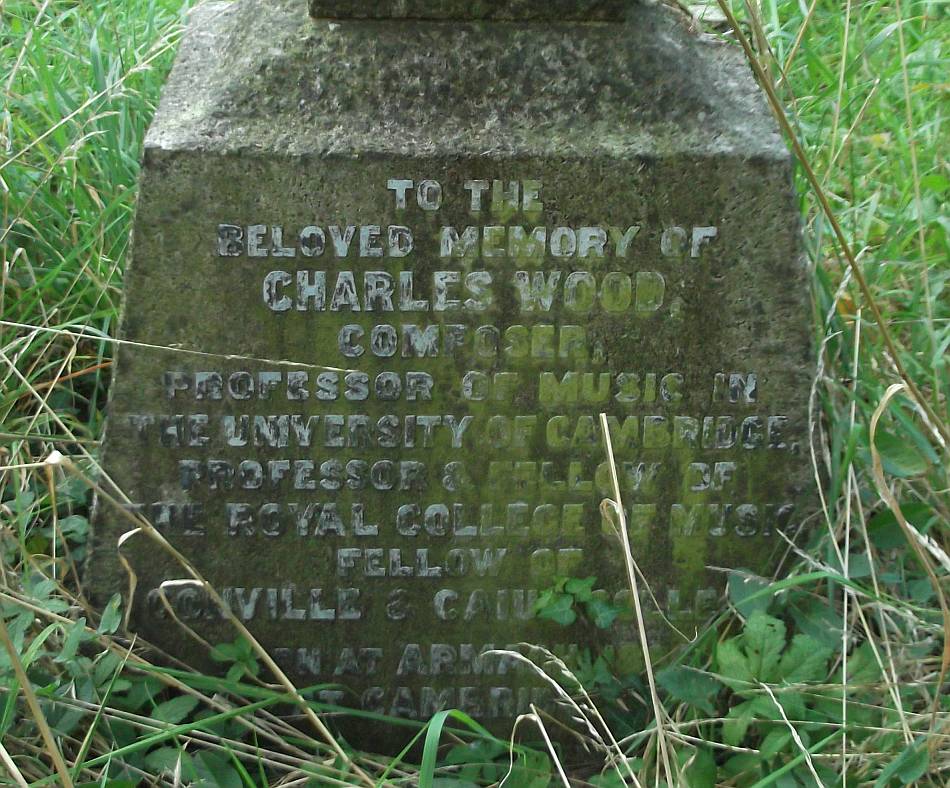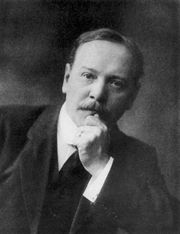Born in Vicars' Hill in the Cathedral precincts of Armagh, Ireland, he was the fifth child and third son of Charles Wood Sr. and Jemima Wood. The boy was a treble chorister in the choir of the nearby St. Patrick's Cathedral (Church of Ireland). His father sang tenor as a stipendiary 'Gentleman' or 'Lay Vicar Choral' in the Cathedral choir and was also the Diocesan Registrar of the church. He was a cousin of Irish composer Ina Boyle.
Wood received his early education at the Cathedral Choir School and also studied organ with two Organists and Masters of the Boys of Armagh Cathedral, Robert Turle and his successor Dr Thomas Marks. In 1883 he became one of fifty inaugural class members of the Royal College of Music, studying composition with Charles Villiers Stanford and Charles Hubert Hastings Parry primarily, and horn and piano secondarily. Following four years of training, he continued his studies at Selwyn College, Cambridge through 1889, where he began teaching harmony and counterpoint. In 1889 he attained a teaching position at Gonville and Caius College, Cambridge, first as organ scholar and then as fellow in 1894, becoming the first Director of Music and Organist. He was instrumental in the reflowering of music at the college, though more as a teacher and organiser of musical events than as composer. After Stanford died, Wood assumed his mentor's vacant role as University of Cambridge Professor of Music in 1924.
Like his better-known colleague, Charles Villiers Stanford, Wood is chiefly remembered for his Anglican church music. As well as his Communion Service in the Phrygian Mode, his settings of the Magnificat and Nunc dimittis are still popular with cathedral and parish church choirs, particularly the services in F, D, and G, and the two settings in E flat; during Passiontide his St Mark Passion is sometimes performed, and demonstrates Wood's interest in modal composition, in contrast to the late romantic harmonic style he more usually employs.
Wood's anthems with organ, Expectans expectavi, and O Thou, the Central Orb are both frequently performed and recorded; as are his unaccompanied anthems Tis the day of Resurrection, Glory and Honour and, most popular of all, Hail, gladdening light and its lesser-known equivalent for men's voices, Great Lord of Lords. All Wood's a cappella music demonstrates fastidious craftsmanship and a supreme mastery of the genre, and he is no less resourceful in his accompanied choral works which sometimes include unison sections and have stirring organ accompaniments, conveying a satisfying warmth and richness of emotional expression appropriate to his carefully chosen texts.
Wood collaborated with priest and poet George Ratcliffe Woodward in the revival and popularisation of renaissance tunes to new English religious texts, notably co-editing three books of carols. He also wrote eight string quartets, and was co-founder (in 1904) of the Irish Folk Song Society.
His pupils included Ralph Vaughan Williams at Cambridge and Herbert Howells at the Royal College of Music. He and his wife suffered the loss of a son in the First World War.
WOOD, CHARLES.
Adm. at SELWYN H., Jan. 16, 1888. [3rd] s. of Charles, lay Vicar of Armagh Cathedral [and diocesan registrar] of Armagh (and Jemima Taylor). B. there [June 15], 1866.
School, Armagh Cathedral.
Matric. Lent, 1888.
Kept five terms.
Migrated to Caius, 1889; Organ Scholar, 1889-94; B.A. and Mus.Bac. 1890; M.A. 1894; Mus.Doc. 1895.
Fellow, 1894-1926; Organist, 1891-1926.
University Lecturer in Harmony and Counterpoint, 1897-1924.
Professor of Music, 1924-6. At the Royal College of Music, 1883-8. Teacher there of Harmony and Counterpoint, 1889-1926.
Hon. LL.D., Leeds, 1904.
Hon. D.Mus., Oxford, 1926.
President of the Musical Association, 1924.
Married, Mar. 17, 1898, Charlotte Georgina, dau. of W. R. Wills-Sandford, Esq., of Castlerea, Co. Roscommon, and had issue.
Composed a series of string quartets, published by the College after his death; music for Greek plays; a musical setting for the Passion according to St Mark; Ode to the West Wind; Dirge for two Veterans; Ballad of Agincourt; Full Fathom Five; Land Dirge; Does the Road wind uphill all the way?; etc.
Composed the chimes for the College clock.
One of the founders of the 'Scales Club.' 'It is no exaggeration to say that Wood had a more beneficent and far-reaching effect on contemporary musical production than any other teacher.' Died July 12, 1926, at Cambridge.
(Venn, II. 504 and note; D.N.B.)
See ODNB.
Born in Vicars' Hill in the Cathedral precincts of Armagh, Ireland, he was the fifth child and third son of Charles Wood Sr. and Jemima Wood. The boy was a treble chorister in the choir of the nearby St. Patrick's Cathedral (Church of Ireland). His father sang tenor as a stipendiary 'Gentleman' or 'Lay Vicar Choral' in the Cathedral choir and was also the Diocesan Registrar of the church. He was a cousin of Irish composer Ina Boyle.
Wood received his early education at the Cathedral Choir School and also studied organ with two Organists and Masters of the Boys of Armagh Cathedral, Robert Turle and his successor Dr Thomas Marks. In 1883 he became one of fifty inaugural class members of the Royal College of Music, studying composition with Charles Villiers Stanford and Charles Hubert Hastings Parry primarily, and horn and piano secondarily. Following four years of training, he continued his studies at Selwyn College, Cambridge through 1889, where he began teaching harmony and counterpoint. In 1889 he attained a teaching position at Gonville and Caius College, Cambridge, first as organ scholar and then as fellow in 1894, becoming the first Director of Music and Organist. He was instrumental in the reflowering of music at the college, though more as a teacher and organiser of musical events than as composer. After Stanford died, Wood assumed his mentor's vacant role as University of Cambridge Professor of Music in 1924.
Like his better-known colleague, Charles Villiers Stanford, Wood is chiefly remembered for his Anglican church music. As well as his Communion Service in the Phrygian Mode, his settings of the Magnificat and Nunc dimittis are still popular with cathedral and parish church choirs, particularly the services in F, D, and G, and the two settings in E flat; during Passiontide his St Mark Passion is sometimes performed, and demonstrates Wood's interest in modal composition, in contrast to the late romantic harmonic style he more usually employs.
Wood's anthems with organ, Expectans expectavi, and O Thou, the Central Orb are both frequently performed and recorded; as are his unaccompanied anthems Tis the day of Resurrection, Glory and Honour and, most popular of all, Hail, gladdening light and its lesser-known equivalent for men's voices, Great Lord of Lords. All Wood's a cappella music demonstrates fastidious craftsmanship and a supreme mastery of the genre, and he is no less resourceful in his accompanied choral works which sometimes include unison sections and have stirring organ accompaniments, conveying a satisfying warmth and richness of emotional expression appropriate to his carefully chosen texts.
Wood collaborated with priest and poet George Ratcliffe Woodward in the revival and popularisation of renaissance tunes to new English religious texts, notably co-editing three books of carols. He also wrote eight string quartets, and was co-founder (in 1904) of the Irish Folk Song Society.
His pupils included Ralph Vaughan Williams at Cambridge and Herbert Howells at the Royal College of Music. He and his wife suffered the loss of a son in the First World War.
WOOD, CHARLES.
Adm. at SELWYN H., Jan. 16, 1888. [3rd] s. of Charles, lay Vicar of Armagh Cathedral [and diocesan registrar] of Armagh (and Jemima Taylor). B. there [June 15], 1866.
School, Armagh Cathedral.
Matric. Lent, 1888.
Kept five terms.
Migrated to Caius, 1889; Organ Scholar, 1889-94; B.A. and Mus.Bac. 1890; M.A. 1894; Mus.Doc. 1895.
Fellow, 1894-1926; Organist, 1891-1926.
University Lecturer in Harmony and Counterpoint, 1897-1924.
Professor of Music, 1924-6. At the Royal College of Music, 1883-8. Teacher there of Harmony and Counterpoint, 1889-1926.
Hon. LL.D., Leeds, 1904.
Hon. D.Mus., Oxford, 1926.
President of the Musical Association, 1924.
Married, Mar. 17, 1898, Charlotte Georgina, dau. of W. R. Wills-Sandford, Esq., of Castlerea, Co. Roscommon, and had issue.
Composed a series of string quartets, published by the College after his death; music for Greek plays; a musical setting for the Passion according to St Mark; Ode to the West Wind; Dirge for two Veterans; Ballad of Agincourt; Full Fathom Five; Land Dirge; Does the Road wind uphill all the way?; etc.
Composed the chimes for the College clock.
One of the founders of the 'Scales Club.' 'It is no exaggeration to say that Wood had a more beneficent and far-reaching effect on contemporary musical production than any other teacher.' Died July 12, 1926, at Cambridge.
(Venn, II. 504 and note; D.N.B.)
See ODNB.
Family Members
Sponsored by Ancestry
Advertisement
Explore more
Sponsored by Ancestry
Advertisement







